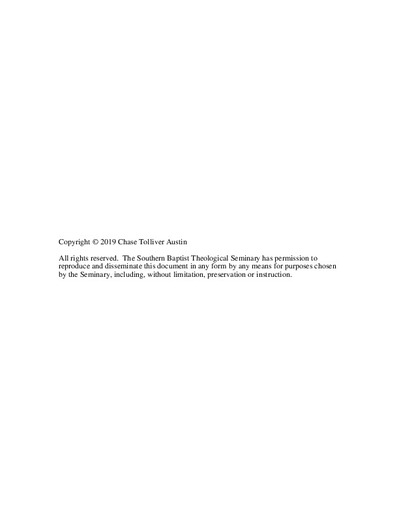| dc.contributor.advisor | Horner, Jeffrey M. | |
| dc.contributor.author | Austin, Chase Tolliver | |
| dc.date.accessioned | 2019-11-27T17:28:00Z | |
| dc.date.available | 2019-11-27T17:28:00Z | |
| dc.date.issued | 2019-11-27 | |
| dc.identifier.uri | https://hdl.handle.net/10392/5984 | |
| dc.description.abstract | This study explored the relationship between the Christian liberal arts and sciences curriculum and academic rigor among classical Christian schools. It used convergent data-transformation methods to analyze publicly available curriculum descriptions in relationship to publicly available academic data. This study correlated the two sets of variables to determine the relationship between the two.
A review of the precedent literature first described the history of the classical Christian school movement then presented the philosophical and theological foundations of the movement. Next it examined studies of both Christian curriculum and academic rigor, both theoretical and practical curriculum studies were reviewed. The term “Christian liberal arts and sciences” was used to describe the curriculum found within classical Christian schools. It also reviewed studies examining selected criteria (AP courses, SAT scores, and acceptances into top-ranked liberal arts colleges and universities) as measures of academic rigor. Very few published studies examined the intersection of both topics and none did so within the classical Christian school movement.
The convergent data-transformation research design consisted of both qualitative and quantitative analyses consisting of four phases. The study required a research population which could demonstrate both the Christian liberal arts and sciences curriculum and academic rigor within a classical Christian school setting, hence the selection of the Association of Classical Christian Schools (ACCS). The first phase collected publicly available qualitative data of the Christian liberal arts and sciences. The second phase gathered both tuition and family income data to control for possible confounding variables. The third phase coded schools’ course descriptions for integration of faith and learning (IFL) language, which was then transformed into quantitative data for further analysis. The fourth phase performed a two-way analysis of variance (ANOVA) on all independent variables and one dependent variable (SAT scores). Following the ANOVA, an analysis of variance with covariates (ANCOVA) was performed to control for the covariate of family income levels.
Overall, this study found that ACCS secondary schools provided academically rigorous curriculum when compared to other categories of schools with regard to SAT scores. Controlling for family income levels did not strengthen the academic rigor measurements. The frequency of IFL language within certain disciplines correlated with both higher and lower academic measures as seen in a positive correlation between Bible courses and math courses with high IFL frequency and above average SAT scores. Science courses with high IFL frequency correlated with above average SAT scores while social studies courses with low IFL frequency correlated with above average SAT scores.
This study utilized a recent methodology for correlating the Christian liberal arts and sciences curriculum and academic rigor within a new context, classical Christian schools. | en_US |
| dc.subject.lcsh | Association of Classical Christian Schools | en_US |
| dc.subject.lcsh | Curriculum evaluation | en_US |
| dc.subject.lcsh | Classical education--Curricula | en_US |
| dc.subject.lcsh | Christian education--Curricula | en_US |
| dc.title | Wisdom, Eloquence, and Academic Rigor in ACCS Schools: A Mixed Methods Study | en_US |
| dc.type | Electronic dissertation | en_US |
| dc.type | Text | |
| dc.contributor.committee | Foster, Anthony W. | |
| dc.type.qualificationname | Ed.D. | en_US |
| dc.publisher.institution | Southern Baptist Theological Seminary | en_US |
| dc.publisher.department | School of Missions and Evangelism | |

